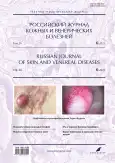Experience of using the interleukin-17A inhibitor secukinumab in the treatment of psoriasis and psoriatic arthritis
- Authors: Molochkova Y.V.1, Petrova M.S.1, Molochkov V.A.1, Monaenkova M.K.1, Abalukhova E.D.1
-
Affiliations:
- Moscow Regional Research and Clinical Institute named after M.F. Vladimirsky
- Issue: Vol 26, No 6 (2023)
- Pages: 563-574
- Section: DERMATOLOGY
- URL: https://journals.rcsi.science/1560-9588/article/view/254768
- DOI: https://doi.org/10.17816/dv569009
- ID: 254768
Cite item
Abstract
Psoriasis is a chronic immune-inflammatory skin disease, which in 25–30% of cases occurs in combination with damage of the musculoskeletal system ― psoriatic arthritis. Nowadays, the leading role in the pathogenesis of psoriasis and psoriatic arthritis is assigned to the activation of the IL-23/IL-17 axis-key cytokines involved in the activation pathway of the effector activity of Th17 lymphocytes. The activity of proinflammatory cytokines secreted by Th17 cells in psoriasis and psoriatic arthritis is also confirmed by the high efficiency of targeted therapy aimed specifically at this pathway. One of the modern genetically engineered biological drugs blocking IL-17 which is used worldwide in the treatment of psoriasis and psoriatic arthritis is secukinumab, a recombinant, fully human monoclonal antibody of high affinity directed against IL-17A.
The article presents data from own 52-week follow-up of secukinumab use in 40 patients with severe and moderate-severe psoriasis which was combined with psoriatic arthritis in 67.5% of cases and demonstrates high efficacy, survival and satisfactory tolerability of this therapy.
Keywords
Full Text
##article.viewOnOriginalSite##About the authors
Yulia V. Molochkova
Moscow Regional Research and Clinical Institute named after M.F. Vladimirsky
Email: yulia.molochkova@yandex.ru
ORCID iD: 0000-0001-9021-6494
SPIN-code: 2051-0250
MD, Dr. Sci. (Med.), Assistant Professor
Russian Federation, 61/2 Shepkina street, 129110 MoscowMarina S. Petrova
Moscow Regional Research and Clinical Institute named after M.F. Vladimirsky
Author for correspondence.
Email: marina.s.petrova@gmail.com
ORCID iD: 0000-0002-1789-2311
SPIN-code: 7797-1699
Russian Federation, 61/2 Shepkina street, 129110 Moscow
Vladimir A. Molochkov
Moscow Regional Research and Clinical Institute named after M.F. Vladimirsky
Email: vlmolochkov@yandex.ru
ORCID iD: 0000-0003-3388-9224
SPIN-code: 2215-1337
MD, Dr. Sci. (Med.), Professor
Russian Federation, 61/2 Shepkina street, 129110 MoscowMaria K. Monaenkova
Moscow Regional Research and Clinical Institute named after M.F. Vladimirsky
Email: mar.monaenkova@gmail.com
ORCID iD: 0000-0001-8479-1978
SPIN-code: 9662-8661
Russian Federation, 61/2 Shepkina street, 129110 Moscow
Elizaveta D. Abalukhova
Moscow Regional Research and Clinical Institute named after M.F. Vladimirsky
Email: ladybird2016@gmail.com
ORCID iD: 0009-0003-5831-4977
Russian Federation, 61/2 Shepkina street, 129110 Moscow
References
- Augustin M, Reich K, Glaeske G, et al. Co-morbidity and age-related prevalence of psoriasis: Analysis of health insurance data in Germany. Acta Derm Venereol. 2010;90(2):147–151. doi: 10.2340/00015555-0770
- Conrad C, Gilliet M. Psoriasis: From pathogenesis to targeted therapies. Clin Rev Allergy Immunol. 2018;54(1):102–113. doi: 10.1007/s12016-018-8668-1
- Singh RK, Lee KM, Ucmak D, et al. Erythrodermic psoriasis: Pathophysiology and current treatment perspectives. Psoriasis (Auckl). 2016;(6):93–104. doi: 10.2147/PTT.S101232
- Xing X, Liang Y, Sarkar MK, et al. IL-17 responses are the dominant inflammatory signal linking inverse, erythrodermic, and chronic plaque psoriasis. J Invest Dermatol. 2016;136(12):2498–2501. doi: 10.1016/j.jid.2016.07.008
- Bissonnette R, Fuentes-Duculan J, Mashiko S, et al. Palmoplantar pustular psoriasis (PPPP) is characterized by activation of the IL-17A pathway. J Dermatol Sci. 2017;85(1):20–26. doi: 10.1016/j.jdermsci.2016.09.019
- Wilsmann-Theis D, Schnell LM, Ralser-Isselstein V, et al. Successful treatment with interleukin-17A antagonists of generalized pustular psoriasis in patients without IL36RN mutations. J Dermatol. 2018;45(7):850–854. doi: 10.1111/1346-8138.14318
- Lories RJ, McInnes IB. Primed for inflammation: Enthesis-resident T cells. Nat Med. 2012;18(7):1018–1019. doi: 10.1038/nm.2854
- Van den Berg WB, McInnes IB. Th17 cells and IL-17: A focus on immunopathogenesis and immunotherapeutics. Semin Arthritis Rheum. 2013;43(2):158–170. doi: 10.1016/j.semarthrit.2013.04.006
- Mease PJ. Inhibition of interleukin-17, interleukin-23 and the Th17 cell pathway in the treatment of psoriatic arthritis and psoriasis. Curr Opin Rheumatol. 2015;27(2):127–133. doi: 10.1097/BOR.0000000000000147
- Rudneva NS, Natarova EV, Kruglova LS. Pustular psoriasis treated with IL-17a antibody secukinumab. Medical alphabet. 2022;1(27):30–36. doi: 10.33667/2078-5631-2022-27-30-36
- Mugheddu C, Atzori L, Lappi A, et al. Successful secukinumab treatment of generalized pustular psoriasis and erythrodermic psoriasis. J Eur Acad Dermatol Venereol. 2017;31(9):e420–e421. doi: 10.1111/jdv.14234
- Shostak NA, Andriyashkina DY, Dvornikov AS, et al. Interleukin 17A inhibitor secukinumab in the treatment of patients with psoriatic arthritis. Klinitsist. 2022;16(2):27–39. doi: 10.17650/1818-8338-2022-16-2-K6655
- Menter A, Strober BE, Kaplan DH, et al. Joint AAD-NPF guidelines of care for the management and treatment of psoriasis with biologics. J Am Acad Dermatol. 2019;80(4):1029–1072. doi: 10.1016/j.jaad.2018.11.057
- Blauvelt A, Chiricozzi A. The immunologic role of IL-17 in psoriasis and psoriatic arthritis pathogenesis. Clin Rev Allergy Immunol. 2018;55(3):379–390. doi: 10.1007/s12016-018-8702-3
- Beringer A, Noack M, Miossec P. IL-17 in chronic inflammation: From discovery to targeting. Trends Mol Med. 2016;22(3):230–241. doi: 10.1016/j.molmed.2016.01.001
- Gottlieb AB, Deodhar A, Mcinnes IB, et al. Long-term safety of secukinumab over five years in patients with moderate-to-severe plaque psoriasis, psoriatic arthritis and ankylosing spondylitis: Update on integrated pooled clinical trial and post-marketing surveillance data. Acta Derm Venereol. 2022;(102):adv00698. doi: 10.2340/actadv.v102.563
- Singh JA, Guyatt G, Ogdie A, et al. Special Article: 2018 American college of rheumatology / National psoriasis foundation guideline for the treatment of psoriatic arthritis. Arthritis Rheumatol. 2019;71(1):5–32. doi: 10.1002/art.40726
- Pizzatti L, Mugheddu C, Sanna S, et al. Erythrodermic psoriasis in a dialyzed patient successfully treated with Secukinumab. Dermatol Ther. 2020;33(3):e13348. doi: 10.1111/dth.13348
Supplementary files
















